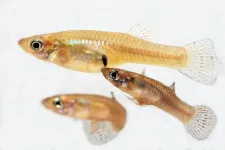(Press-News.org) COLUMBUS, Ohio - Female vampire bats establish an egalitarian community within a roost rather than a society based on a clear hierarchy of dominance that is often seen in animal groups, a new study suggests.
Researchers observed more than 1,000 competitions for food among a colony of 33 adult female bats and juveniles living in captivity, assigning a rank to each bat based on a calculation of wins and losses in those contests.
The team found that, unlike in many mammal societies, the higher-ranking animal didn't necessarily win every bout over food, and there was a randomness to the ranking order - no specific quality they measured gave a bat a better chance at dominance, so any adult female had an equal opportunity to rank very high or very low on a scale of dominance in the roost.
Traditionally, research on group-living animals - especially primates - in the wild has focused on how a dominance structure factors into survival, longevity and healthy offspring, and only later considered the importance of friendship in those same communities.
Senior study author Gerald Carter has worked in reverse order. His research on highly social female vampire bats, whose behaviors resemble what's been observed in some primate groups, has focused on cooperation, finding that vampire bats make "friends" through a gradual buildup of trust and show signs of maintaining those friendships in the wild.
"We realized we don't know anything about dominance among female vampire bats, so this is a first step in the direction of trying to identify how similar they are to primates in this way," said Carter, assistant professor of evolution, ecology and organismal biology at The Ohio State University. "We can say quite clearly that they're definitely not like some of the well-studied primates. They don't have a very clear social rank that they're constantly enforcing."
The study is published today (July 7, 2021) in the journal Royal Society Open Science.
The research team video-recorded 1,023 competitive interactions concerning food over three months in a captive colony of common vampire bats at the Smithsonian Tropical Research Institute (STRI) in Panama. The colony consisted of 24 adult females captured from two distant sites as well as nine young bats - four males and five females.
Winners and losers were identified from five types of events at the blood-meal feeders: displacement of a feeding bat by an intruding bat with or without physical contact; a feeding bat's maintenance of its position following an approach by another bat, with or without contact; and a nearby bat waiting to eat until after a feeding bat leaves the feeder.
Researchers assigned social rank to individual bats based on wins and losses and found widespread variability in adult female bat rankings, with essentially no predictors for how these community arrangements played out. No associations were found between body size, age and reproductive status and dominance ranking, and common vampire bat behaviors of grooming and sharing food were not associated with social rank. Being related to each other had no effect. The only possible predictor detected, when male juveniles were excluded, was smaller forearms in the more dominant adult females.
When compared to data that exists on communities of female yellow baboons and female long-tailed macaques, the vampire bats were also far less likely to show a consistent pattern of wins by the more dominant community members.
"Basically, with these primates, almost 100% of the time the dominant individual wins," Carter said. "With vampire bats, even when you have two individuals that are 10 rankings apart, the more dominant individual is not necessarily displacing the other one."
The findings suggested that young males are subordinate to adult females, and the same is likely to be true for adult males because they are smaller than female vampire bats. Previous research has shown that male vampire bats do compete with each other and fight - and within a colony, males tend to focus on establishing territory rather than carrying on social relationships.
A comparison of group-level dominance measures between female vampire bats and 14 other documented female mammal groups - including African elephants, bison and numerous primates - placed the bats as either 12th or 15th in the overall dominance ranking, depending on the metric used.
Though the single study of animals in captivity doesn't provide all the answers, the research does suggest vampire bats live in communities that are "more fluid and open," Carter said. A fluid and open society is different from, but not necessarily better than, a group characterized by dominance and hierarchy, he noted. A clear power structure actually helps prevent conflict.
"In a group of animals that's always together, it's really important to work out who's dominant, because when you come across food, you all come across that food together," he said.
"With vampire bats, they have this society inside of a tree, and all of the relationships are worked out. But we think vampire bats don't hunt as a stable group - they go out and forage, and come back together. So what that means is that they're not always coming across a food resource together and having to decide who's going to get access to it first."
INFORMATION:
This work was supported by the STRI and the National Science Foundation.
Co-authors Rachel Crisp and Lauren Brent of the University of Exeter in the United Kingdom also worked on the study.
Contact: Gerald Carter, Carter.1640@osu.edu
Written by Emily Caldwell, Caldwell.151@osu.edu
Environmental education provision needs greater investment and innovation if future generations are to be able to respond fully to the climate emergency, experts have said.
The deepening environmental crisis will continue to worsen if there is not significant support and investment in environmental and science education, researchers have warned. Reforms would help young people to address the complex, interlinked and dynamic issues of our contemporary situation.
The experts argue Governments and other organisations must direct more funding to education innovation in response to consistent warnings from scientists about trends in the deteriorating state of ecosystems, biodiversity and climate, amongst other environmental issues.
Writing in Environmental Education ...
In mosquitofish, of the genus Gambusia, male fish are smaller than females - sometimes only half the size. Biologists had previously assumed that smaller male mosquitofish had at least some reproductive advantages. Researchers from the transregional collaborative research centre NC³ at Bielefeld University have shown in a systematic review and meta-analysis that larger mosquitofish are actually more successful at reproduction: they can, for instance, better challenge their rivals; they produce more sperm; and they are preferred by female fish. The re-searchers are presenting their findings today (07.07.2021) in the Journal of Animal Ecology.
Mosquitofish are small fish with nondescript coloring of the genus Gambusia, which contains some 45 species. ...
There are some large shield volcanoes in the world's oceans where the lava is usually not ejected from the crater in violent explosions, but flows slowly out of the ground from long fissures. In the recent eruption of the Sierra Negra volcano in the Galapagos Islands, which lie just under a thousand kilometres off South America in the Pacific Ocean, one of these fissures was fed through a curved pathway in June 2018. This 15 kilometre-long pathway, including the kink, was created by the interaction of three different forces in the subsurface, Timothy Davis and Eleonora Rivalta from the GFZ German ...
Driving through a tunnel is a challenging and risky task. Drivers need to lower their speed and adapt to poor light, while the enclosed space may make them anxious. Preventing accidents is a public health challenge that uses insights from engineering, psychology, physiology, and neuroscience. Here, in a virtual reality (VR) study in Frontiers in Psychology, scientists from China, Canada, and the USA show that playback of slow music inside tunnels can reduce tension and fatigue in drivers, making them less prone to speeding and overtaking. These results imply that well-chosen background music can help improve road safety.
"When drivers go through a tunnel, they need to process a large amount ...
How do predators know to avoid brightly-coloured toxic prey? A collaboration of researchers has put social information theory to the test in a reliable real-world system to find the answer - by copying what others do, or do not, eat.
An international team of researchers from Finland, New Zealand, Colombia and the U.K. have provided the first evidence that wild birds can learn to avoid distasteful prey by observing what others eat.
"We've known for a long time that predators, like birds, associate brightly coloured warning signals with the danger of eating certain prey types. However, ...
Imagine a dust particle in a storm cloud, and you can get an idea of a neutron's insignificance compared to the magnitude of the molecule it inhabits.
But just as a dust mote might affect a cloud's track, a neutron can influence the energy of its molecule despite being less than one-millionth its size. And now physicists at MIT and elsewhere have successfully measured a neutron's tiny effect in a radioactive molecule.
The team has developed a new technique to produce and study short-lived radioactive molecules with neutron numbers they can precisely control. They hand-picked several isotopes of the same molecule, each with one more neutron than the next. When they measured each molecule's energy, they were able to detect small, nearly imperceptible changes of the nuclear ...
BOSTON - The numbers of cancer screening tests rebounded sharply in the last quarter of 2020, following a dramatic decline in the first months of the COVID-19 pandemic, at one large hospital system in the Northeastern United States. These findings were released in a study published in Cancer Cell. The research also found an increase in racial and socioeconomic disparities among users of some screening tests during the pandemic.
Study co-senior author Toni K. Choueiri, MD, director of the Lank Center for Genitourinary Oncology at Dana-Farber Cancer Institute, said following a dramatic decline during the first pandemic peak, there was a "substantial increase in screening procedures during the more recent periods ...
LAWRENCE -- A new paper appearing in Biology Letters describes the oldest-known fragmentary bat fossils from Asia, pushing back the evolutionary record for bats on that continent to the dawn of the Eocene and boosting the possibility that the bat family's "mysterious" origins someday might be traced to Asia.
A team based at the University of Kansas and China performed the fieldwork in the Junggar Basin -- a very remote sedimentary basin in northwest China -- to discover two fossil teeth belonging to two separate specimens of the bat, dubbed Altaynycteris aurora.
The new fossil specimens help scientists better understand ...
Dutch-French research shows that Optical Genome Mapping (OGM) detects abnormalities in chromosomes and DNA very quickly, effectively and accurately. Sometimes even better than all existing techniques together, as they describe in two proof-of-concept studies published in the American Journal of Human Genetics. This new technique could radically change the existing workflow within cytogenetic laboratories.
Human hereditary material is stored in 46 chromosomes (23 pairs). Although those chromosomes are quite stable, changes in number or structure can still occur. A well-known example is Down syndrome, which is caused by an extra ...
A decade's worth of data shows that neonatologists are shifting the type of respiratory support they utilize for preterm infants, a move that could lead to improved health outcomes.
Using two large national datasets that included more than 1 million preterm infants, researchers in a new Vanderbilt-led study found that from 2008 to 2018 there was a greater than 10% decrease in the use of mechanical ventilation for this patient population. Concurrently, there was a similar increase in the use of non-invasive respiratory support, such as continuous positive airway pressure (CPAP), for these infants.
The ...


